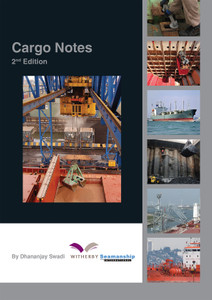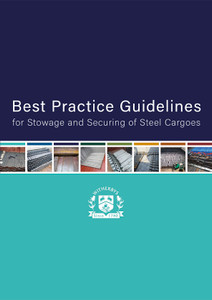
This publication continues the ‘Notes’ series for cadets and junior officers and provides an introduction to bulk carriers, discussing ship types, their cargoes and trade. Guidance is provided on cargo handling, draught survey, ballast water management and actions to be taken on passage.
This is a good modern introduction to bulk carriers and bulk cargoes.
It describes and illustrates the various types of bulk carrier, including their structures and equipment, and outlines potential hazards presented by bulk cargo, such as shifting, liquefaction, overheating, oxygen depletion, ship stress and corrosion.
Details are provided on the parties, documentation and terminology encountered in bulk trade. There is also practical guidance covering all stages of cargo handling, including hold preparation and testing, stowage planning, information exchange, transfer equipment, draught survey, monitoring on passage and preparations for discharge.
The Appendices contain example loading calculations, checklists, reporting forms and other essential documentation, as well as case studies illustrating the causes of explosion, structural failure, crew injury, etc.
1 Bulk Carriers
1.1
Introduction
1.2
Bulk
Carrier
Design
1.3
Types
of
Bulk
Carrier
by
Size
1.4
Types
of
Bulk
Carriers
According
to
Trade
1.5
Hybrid
Configuration
(HyCon)
Bulk
Carriers
1.6
Stresses
in
Bulk
Carriers
1.7
Structural
Problems
Associated
with
Bulk
Carriers
1.8
Structural
Standards
for
Bulk
Carriers
2
Bulk
Cargoes
2.1
Introduction
2.2
Terminology
Used
in
Bulk
Cargo
Operations
2.3
Recommended
Publications
for
Bulk
Cargo
Carriage
2.4
Intact
Stability
Criteria
According
to
the
International
Load
Line
Convention
2.5
Hazards
Associated
with
Bulk
Cargoes
2.6 Examples of Bulk Cargoes
3
Bulk
Trade
3.1
The
Voyage
3.2
Voyage
Orders/Instructions
3.3
Charter
Parties
for
Bulk
Trade
3.4 Load Line Zones and Calculations
4
Cargo
Loading
4.1
Hold
Preparation
4.2
Silver
Nitrate
Test
4.3
Ship
Shore
Information
Exchange
4.4
Cargo
Samples
when
Loading
4.5
Loading
Methods
4.6
Fumigation
4.7
Cargo
Documentation
4.8
Loading
Cargo
During
Rain
5
Draught
Survey
5.1
Objective
of
Draught
Survey
5.2
Steps
for
Draught
Survey
5.3
Reading
Draughts
5.4
Taking
Density
5.5
Cargo
Weight,
Volume
and
Ullage
Measurement
5.6
Bunker
Quantity
Estimation
5.7
Precautions
During
Draught
Survey
5.9
Deadweight
Surveys
6 Ballast Water Management
6.1
Ballast
Water
Exchange
Methods
6.2
Ballast
Water
Exchange
Requirements
6.3
Ballast
Water
Management
System
7
The
Voyage
7.1
Conditions
of
Carriage
7.2
Ventilation
7.3
Discharging
Hold
Bilges
7.4
Periodic
Checks
7.5
Logs
and
Record
Keeping
7.6
BLU
Manual
7.7
Bulk
Carrier
Loading
Manual
8
Cargo
Discharging
8.1
Discharging
Plan
8.2 Arrival at the Discharge Port
8.3
Notice
of
Readiness
8.4
Cargo
Samples
when
Discharging
8.5
Cargo
Calculation
–
Draught
Survey
8.6
Discharging
Methods
8.7
Cargo
Damage
Surveys
8.8
Hold
Damage
Surveys
Appendices
Acronyms
and
Abbreviations
Case
Studies
Master Mariner, MICS, PG Cert (Shipping), MSc (CBIS), HND Nautical Science, BSc (Maritime Studies)
Abdul Khalique was awarded the President of Pakistan Gold Medal for best cadet during BSc Maritime Studies at Pakistan Marine Academy and received the High Achievement Award and the Merchant Navy Association (Tasmania) prize on completion of second mate studies from the Australian Maritime College.
After spending some time at sea, Abdul pursued a shore-based career. He was a Principal Lecturer in Maritime and Offshore Safety at Warsash Maritime Academy, a role that led him to the position of Head of the LJMU Maritime Centre at Liverpool John Moores University.
- Number of Pages:
- 188
- ISBN:
- 9781856093996
- Published Date:
- August 2010
- Binding Format:
- Paperback
- Book Height:
- 235 mm
- Book Width:
- 155 mm
- Weight:
- 0.7 kg
- Author:
Abdul Khalique
- Preview:
- Yes






